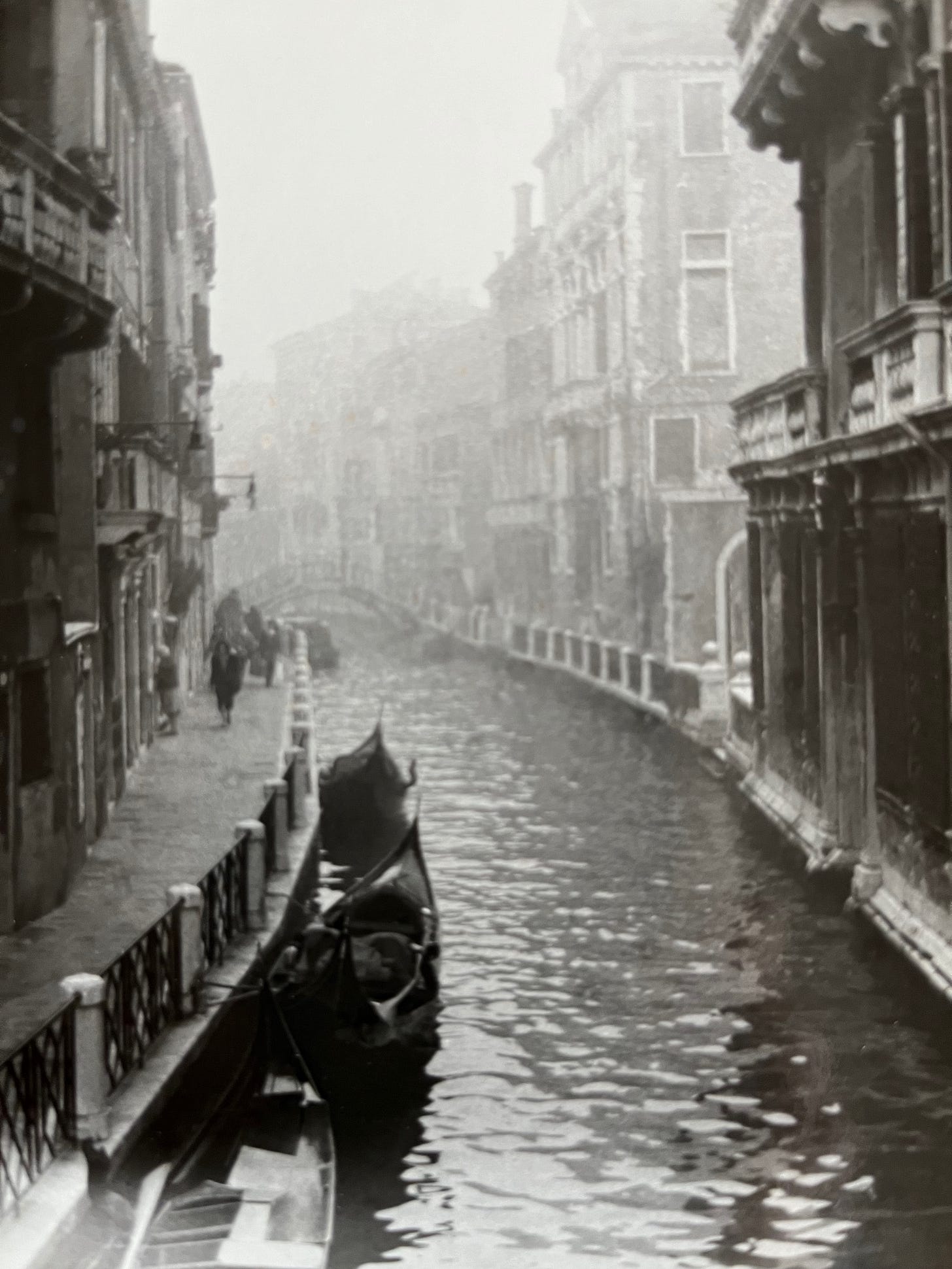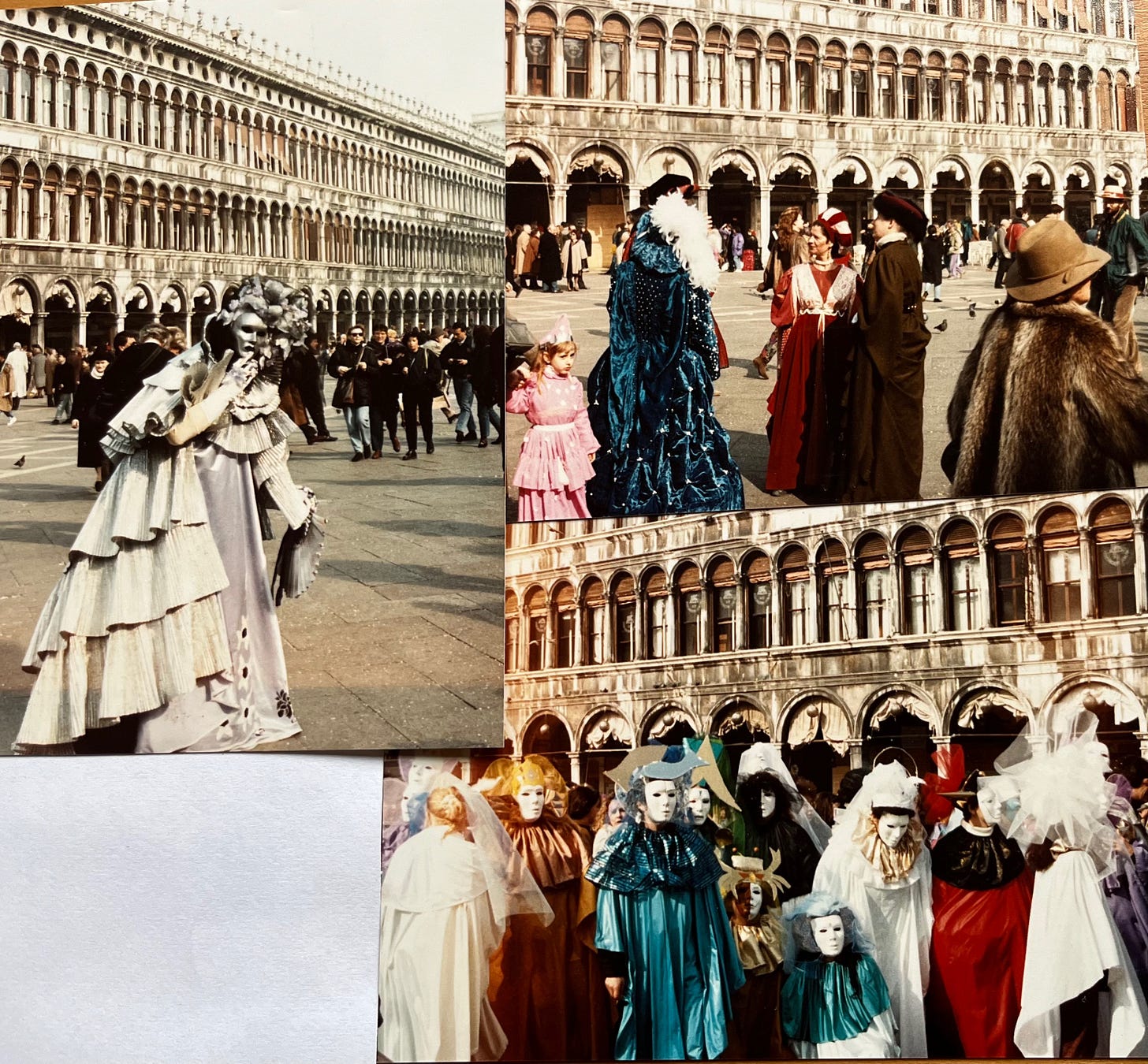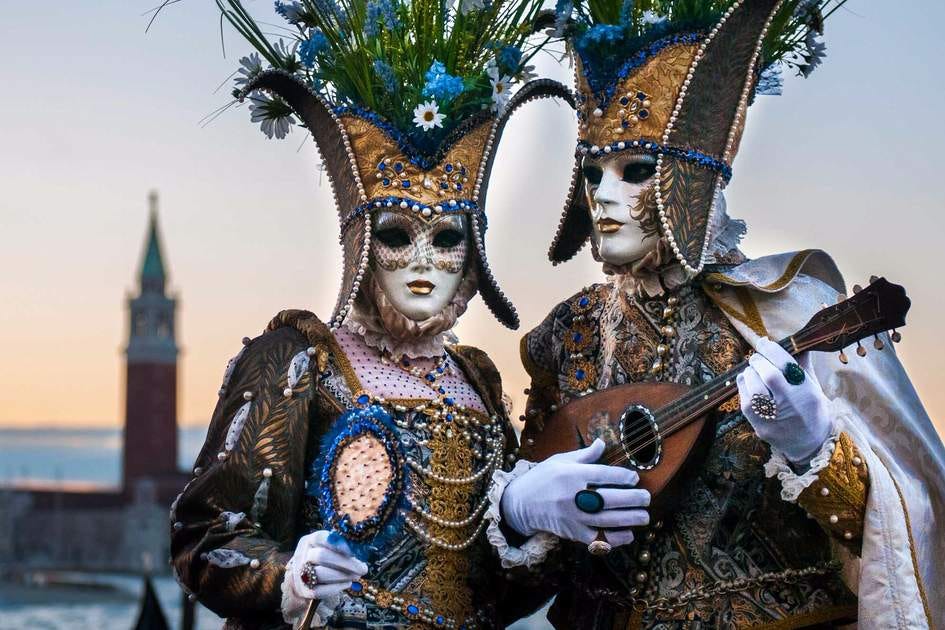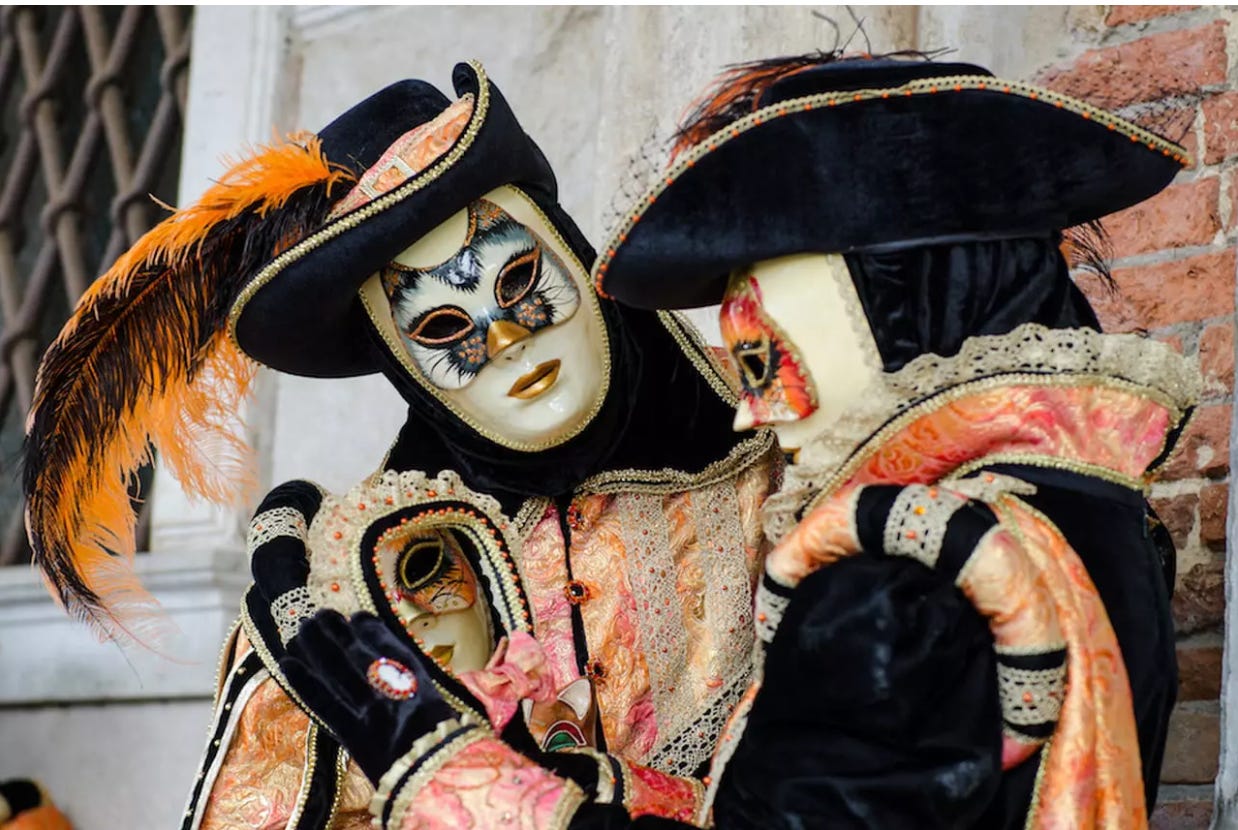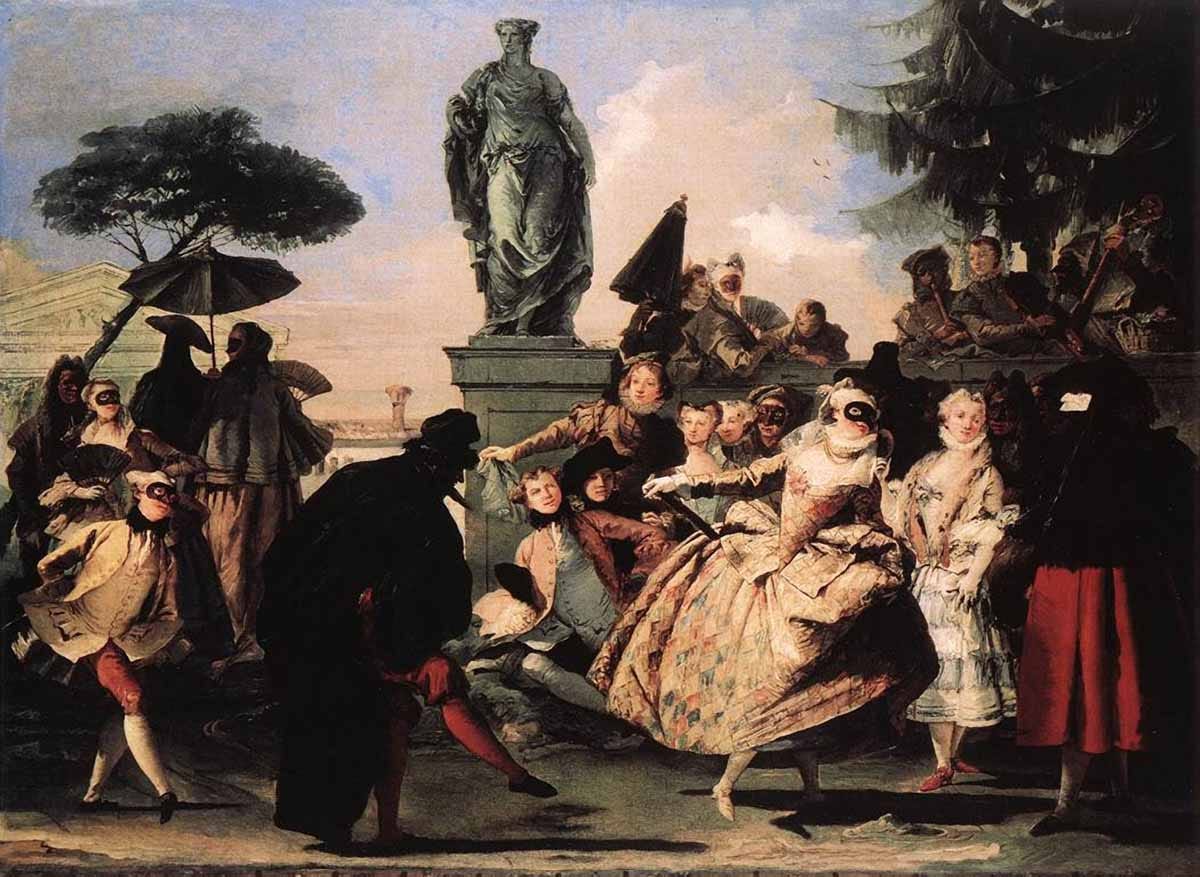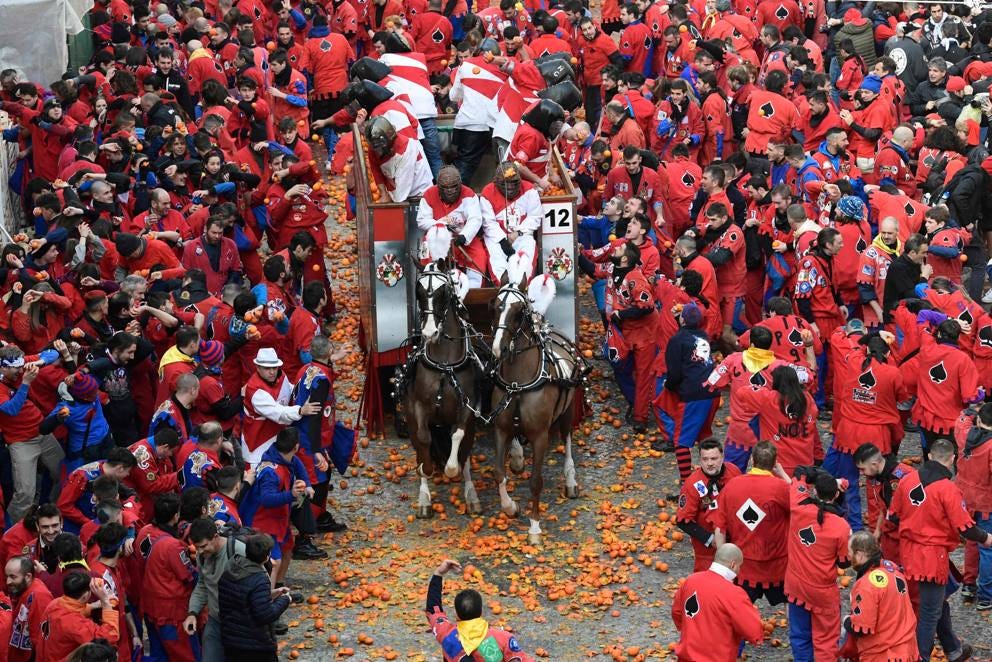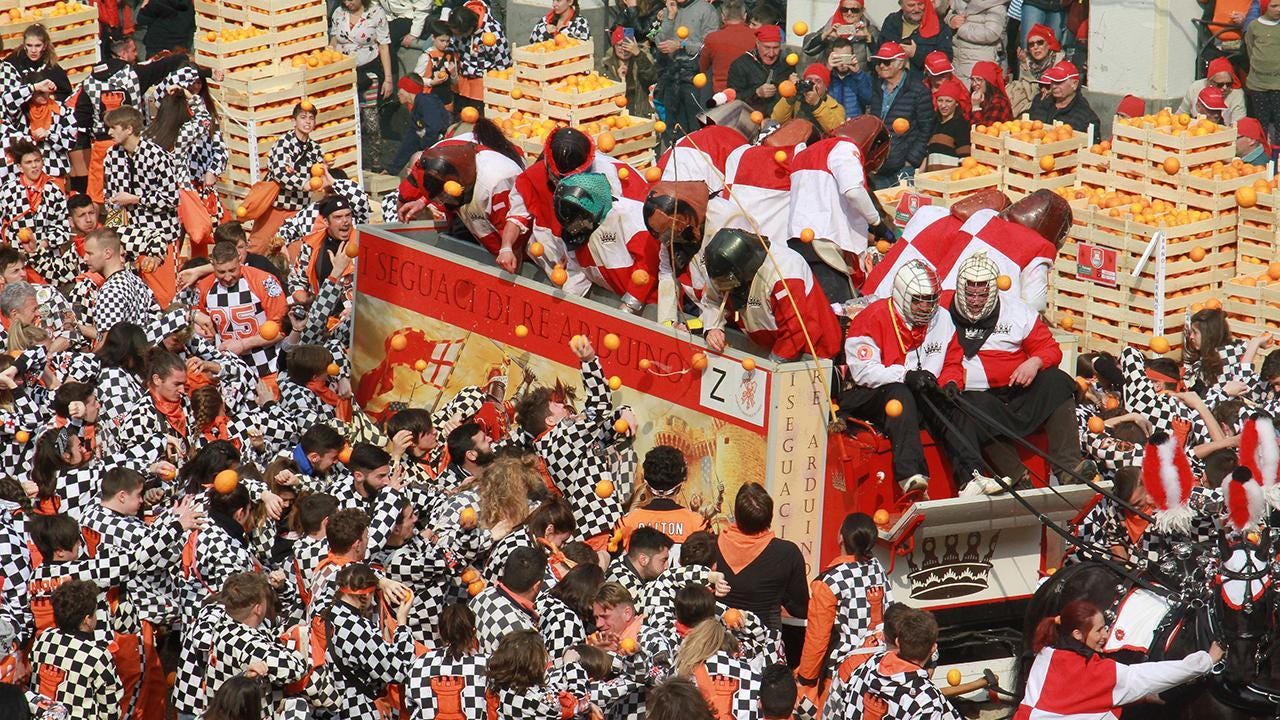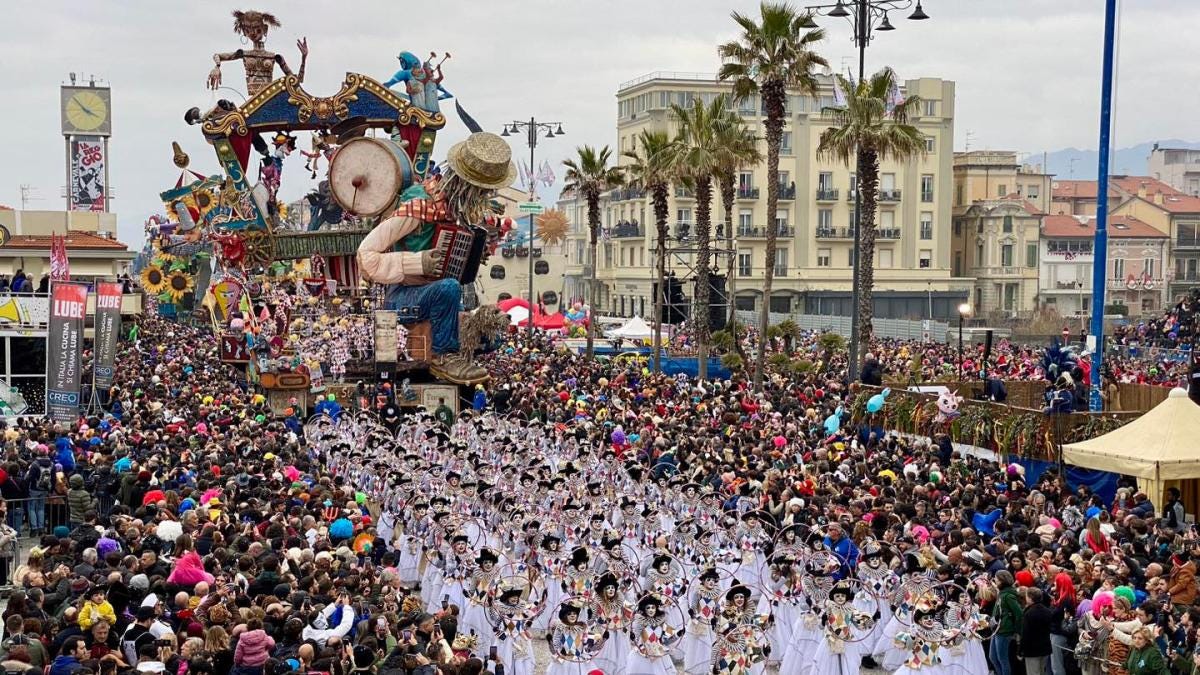Carnival is Not Over
Because the need to drink, dance, celebrate, subvert is a primary force of humanity.
From ancient ritualistic origins, the use of artifice to package the truth is an enduring custom of culture. Historical roots of modern celebrations in Venice, Ivrea, and Viareggio. The power of masks to embody our real self as we switch context. A time to lose control, and a time to regain it.
It was as if the fog had descended on the city the moment we came down the long steps of the train station. Venice appeared veiled in a protective cloud that enveloped buildings, homes, people, costumes all the way to the plashing water.
We adjusted our eyes to lap the scene out of a film as we came across the first hints of color. Then, like an abundant river, a wave of anonymous figures began to come at us, silent. Piazza San Marco was dirty, yet alive—locals the protagonists, for once.
They were a sight to behold. From muted pastels to vibrant hues, themed groups followed the rare lone silhouette. Each emerged from the fog, stopped to pose in interesting compositions, then swooshed by to float away and fade in the distance.
They were gone, like in a dream suggestive of a different path—an invitation to take on a new identity. 1990 was the last year I took the train up to Venice for Carnival, a celebration aimed at subverting the established order and fomenting chaos.
From its origins, Carnival’s purpose is to resurrect a renewed cosmic balance. Though Lent already began, we’ve not left our masks behind. In fact, despite the claims of objectivity and rationality, humanity is in the thick of it. Because the need to drink, dance, celebrate, and subvert is our primary force.
Reminder: You can support my work and get extra insights—in-depth information, ideas, and interviews on the value of culture.
Join the premium list to access new series, topic break-downs, and The Vault.
Although its etymology has Christian origins (Carnem levare, or ‘to deprive oneself of meat,’ which refers to the banquet that preceded Ash Wednesday on mardi gras), Carnival has much older origins.
Carnival makes me happy. It makes it place at the tail-end of winter to express the desire for freedom, madness, and transgression that is in our soul. The last social survival of the great rituals of antiquity.
“I would believe only in a God that knows how to Dance.”
Friedrich Nietzsche emphasized the act of dancing to highlight how freedom, creativity, and spirituality are interconnected. In dance, there’s a sense of liberation, spontaneity, and harmony that transcends the confines of rigid dogma or beliefs.
The Eleusinian and Orphic Mysteries were structured initiatory rites that emphasized purification, while the Dionysian Mysteries embraced ecstatic experiences. Dionysus is Lysios, ‘he who loosens,’ the liberator. These mysteries resembled the tantric rituals in which human beings became acquainted with the wildest, most powerful, and freest part of themselves and experimented in ‘making soul.’
But Carnival also makes me sad. Because it shows me how the meaning and power of the ancient rituals—including a detoxification process of body and mind—has been domesticated, betrayed, vulgarized, and, with that, neutralized.
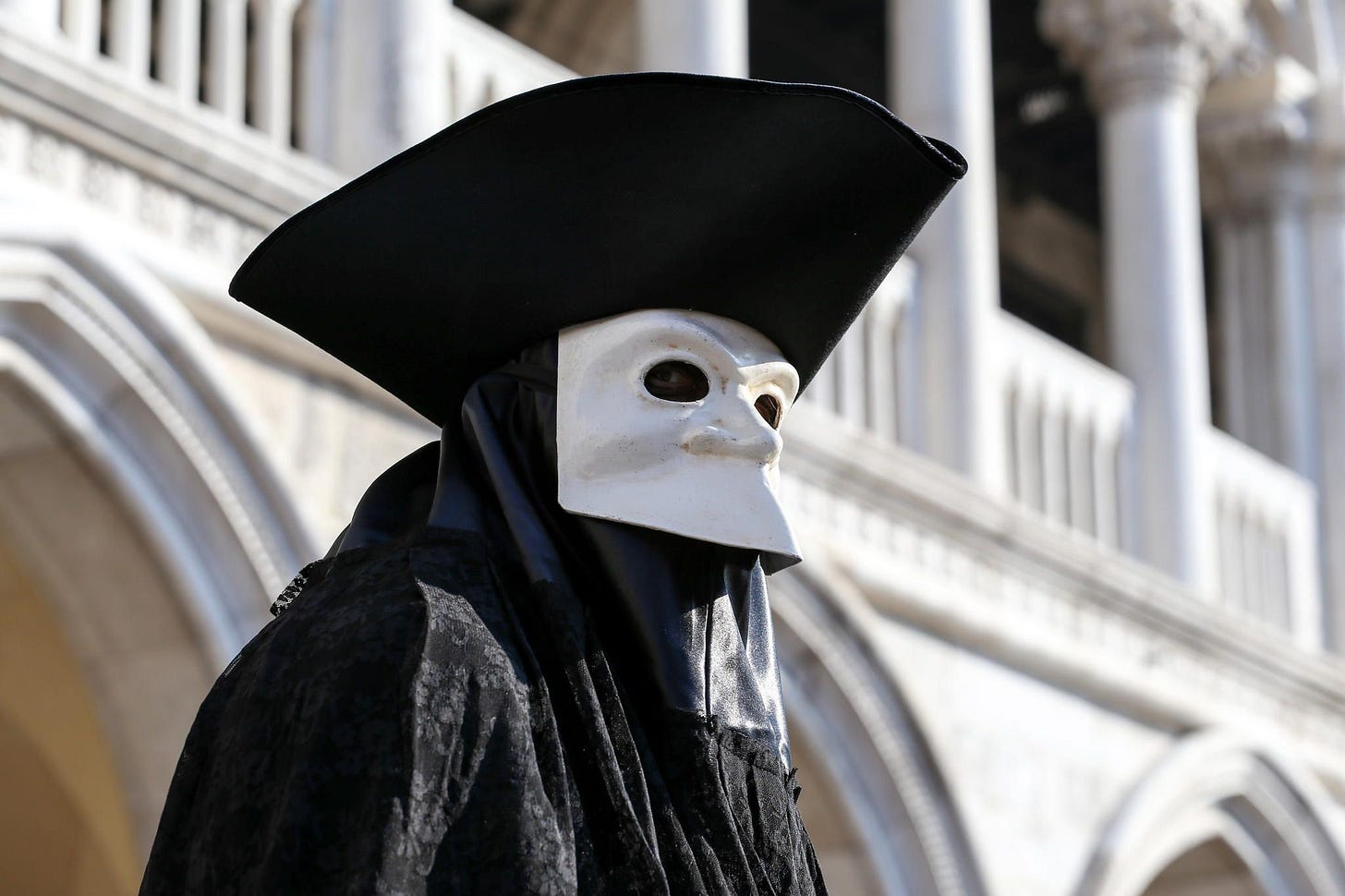
Carnival should be the very moment in which, wearing a mask, we discover and reveal the main theme of our existence. Like Greek theater, it should reveal our darkest and deepest feelings, which, brought to light in a circumscribed context, like the ritual.
The celebration of the Dionysian is key—that mad and dark aspect of our soul, without which there can be no true vision, no true realization, because he who has never been mad can in no way be wise.
We live our lives as myths on a stage, and we resolve, redeem, free ourselves in the moment in which we ‘sees’ the myth that we stage by living. Thanks to ecstasy and disguise we leave our social self, the idea of being someone, and can be any person.
Powerful unconscious forces are the gateway to positive transformation. During the period in which ‘the world is upside down,’1 we open the door to the multiplicity of being, overcoming social barriers.
Vices and roles in Venetian society
We know for sure that Carnival was already mentioned in a 1094 document that talks about public entertainment in the days preceding Lent. The Doge Falier officially granted all citizens of Venice the right to participate in the celebrations. Perhaps it was a coincidence, but that same year the body of Saint Mark was miraculously found.
The first Carnival masks were born in Venice in the 1270s.
Made of clay, papier-mâché, plaster and gauze and then colored and decorated with beads, plumage, embroidery and so on by the so-called mascareri, true craftsmen of true schools, they represent and desecrate the vices of society and allow men and women, since the dawn of time, to put aside their identity and experiment with alternative roles in complete anonymity.
It’s no coincidence that originally, the greeting of the Venetians in disguise was “Good morning, lady mask” in respect of the character that, from time to time, each one chose to interpret. The most common in Venice are the Baùta, the Gnaga for men and the Moretta for women.
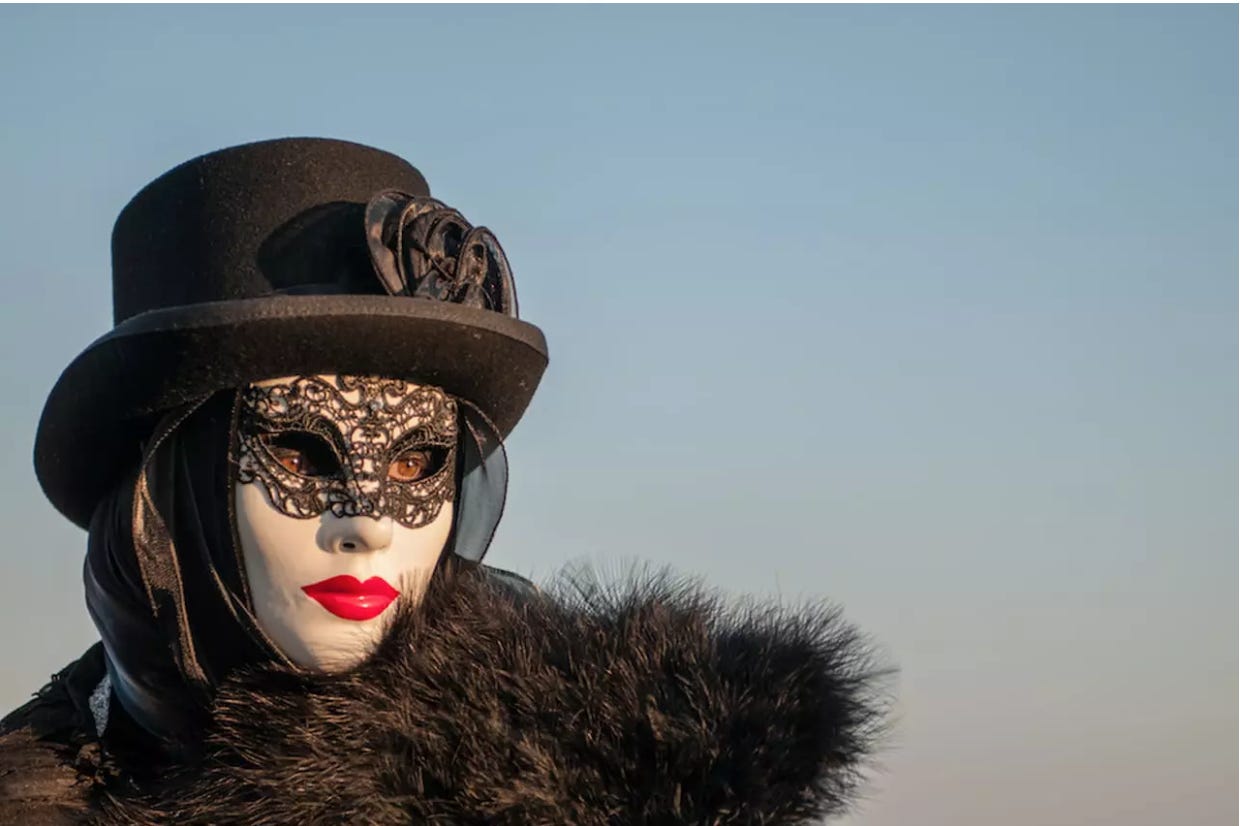
The Mascareri were true craftsmen. They created masks of increasingly rich and sophisticated shapes and workmanship. So much so, that in 1436 they were officially recognized as a profession. (Nothing in common with the cheap tourist trinkets today.)
In the golden years of the Serenissima, Carnival’s official start was on December 26, the day of St. Stephen. It ended at midnight on mardi gras, the day before the start of Lent. In the ritual of the first day, the Doge visited the relics of the Protomartyr in the church of San Giorgio Maggiore.
For the nobles, it was instead an occasion for the ‘liston,’ or the walk of the masks in Piazza San Marco under the Procuratie, an opportunity to show off and flaunt their wealth. Initially, this walk was in Campo Santo Stefano where there was a special paved list (hence liston) that crossed the beaten earth, then it moved to the Piazza.
Stages were built in the main places of the city, where jugglers, acrobats, musicians and performers from all over performed. Street vendors offered dried fruit, chestnuts and sweets of all kinds, but the Frìtoe (fritters) were the Venetians' favorite sweet.
In addition to large-scale events in open spaces, small performances and shows of all kinds (even very transgressive ones) soon spread to private homes, theaters, and cafés. The homes of sumptuous Venetian palaces began to host grandiose and very long parties with lavish masked balls.
In the 18th century, the Venice Carnival reached its maximum splendor and international recognition, becoming very famous and prestigious throughout Europe at the time.
However, starting in 1797, under the French and then Austrian occupation, all masquerades were prohibited, except for private parties in palaces. Thus, the Venice Carnival quickly lost its spirit and began its decline, resisting to a minimal extent only on the major islands of Burano and Murano.
It took nearly two centuries for the Venice Carnival to rise from its ashes. Thanks to the initiative and commitment of some citizens' associations and the logistical and economic contribution of the Municipality of Venice, the Teatro la Fenice, the Venice Biennale and the tourist boards.
In 1979 the Venice Carnival was reborn. Every year public events and parties are organized with a different theme, which the organizers choose from the many subjects that are part of the thousand-year history of this city.
With the incredible creativity on display in Carnival masks, Venice follows its storied artistic tradition. Individuals and groups invest their energy to gain entry into the rarefied world of imagination—a world once the domain on the wealthy alone.
Ivrea, from folklore to the world-famous battle of the oranges
The Carnival of the Piedmont town has its roots in a legendary tradition of medieval origin. Over time, however, it has also become a precious symbol of unity and culture. This is nuts, but they actually throw tons of oranges at carts and each other.

The sweet scent of citrus hangs in the air. For many, it evokes warm, sunny memories. But for the people of Ivrea, it conjures up images of utter chaos, flying oranges, and the camaraderie of friends.
Every year during Carnival, this charming town at the foot of the Alps is transformed into a battlefield. The town’s population swells by the thousands, made up of visitors and the infamous aranceri (orange throwers) who are here for one thing: to wage war with oranges.
Crowds gather to watch the action as hundreds of citrus projectiles cloud the sky. The Ivrea Carnival is a blend of history and legend that unfolds over four days. The festivities are an unforgettable mix of parades, ceremonial fires, and regional cuisine.
It is said that the orange throwers fight was in the name of Violetta, daughter of a medieval miller. A notorious tyrant claimed the ius primae noctis, the right to sleep with his bride on Violetta’s first night of marriage.
In the legend, rather than succumb to his misdeeds, Violetta got the feudal lord drunk, cut off his head while he was sleeping and presented it triumphantly to the citizens, inciting a revolt.
History or legend, every year the city elects a modern Violetta who threw sweets in the parades and watched over the festivities. The throwing of oranges only began after the World War II.
Today, from Carnival Sunday to mardi gras, the orange throwers battle it out to the last peel. The Battle of the Oranges friendly conflict takes place in designated squares and streets throughout the city.
Nine groups of orange throwers on foot, distinguished by their colorful uniforms and different emblems, throw the oranges one by one at the horse-drawn carriages loaded with armored men representing the tyrant and his guards.
An estimated 900 tons of oranges that come from Sicily and other southern regions are thrown during the festival. By the end of the third day of battle, a thick ocher paste of orange peel and pulp covers the medieval squares and cobbled alleys of Ivrea.
As the carnival draws to a close, spectators and orange throwers gather in the town’s medieval squares for the burning of the scarlo, an imposing pole covered in heather and juniper and crowned with an Italian flag.
Children representing Ivrea’s parishes (the Abbà) set fire to individual scarli in three different squares, inviting everyone to lay down their oranges and gather in peace—the whole thing is quite a squeeze.
Viareggio’s traveling theaters
Gigantic allegorical works in papier-mâché are the soul of the Viareggio Carnival. From paper, the artists of Viareggio create extraordinary allegorical floats that defy the laws of physics with their size and their astonishing movements.

Thanks to papier-mâché, the builders of Viareggio can create real traveling theaters. Over 20 meters high, 12 meters wide, the allegorical floats are created to amaze and involve the public during the show of the Masked Courses.
The floats are spectacular constructions that defy the laws of physics. Allegorical images tell stories, traditions, vices and virtues of the human soul, famous people with their qualities and critical issues—they don’t spare political satire.
21 artisan companies, with hundreds of people at work make these marvels. To make the floats with tracing paper, these artisans use about 5 tons of newspaper pages every year, mixed with water, glue and flour.
The Viareggio Carnival dates back to 1873. In those years it was an elite party, celebrated in the sumptuous premises of the Puccini Theater and the Royal Casino. A group of young people who went the parties had the idea of organizing a parade.
Precursors of the famous allegorical floats of today, they were carriages filled with flowers that traveled along the city's Via Regia for the first time on February 24, 1873, on mardi gras. The allegorical floats replaced the flowered carriage in 1883.
Monumental floats were then wooden and jute structures, modeled and set up by local artisans and workers. At the beginning of the 20th century the bacchanal moved to the seaside promenade, a splendid natural stage that brought even more stimulation and prestige to the Carnival.
1921 was the year in which the event began a self-promotion campaign. The city created an official anthem ‘Coppa di Champagne’ and an official magazine ‘Viareggio in maschera.’ But the turning point that transformed the Viareggio Carnival into the carnival we know today, was 1925.
In that year, they invented the technique of using cast paper—papier-mâché—to build the floats. This extremely malleable material allowed the builders to create increasingly larger and more complicated floats that remained incredibly light.
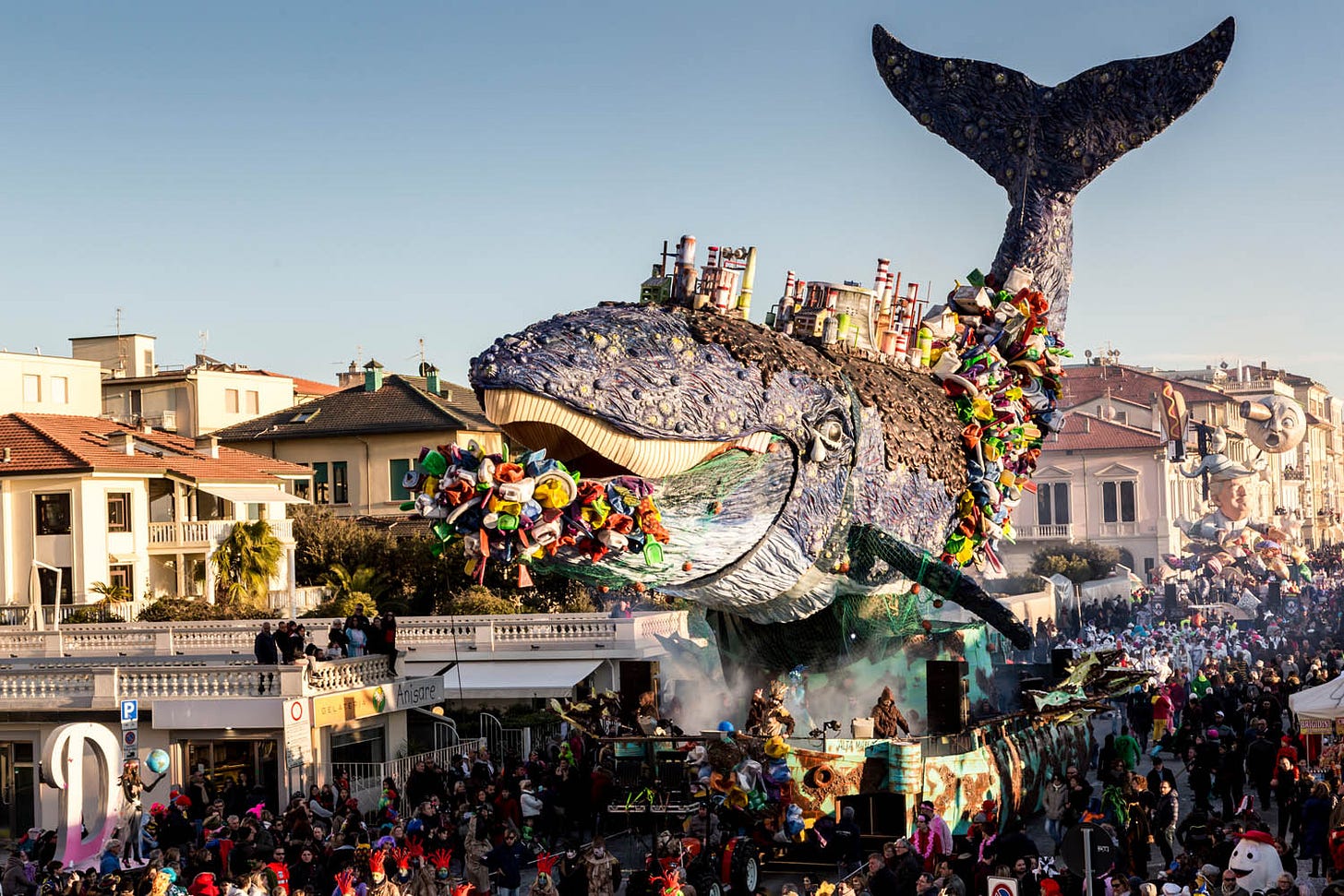
In 1930, painter Uberto Bonetti created the symbolic mask of the carnival: the Burlamacco, which summarizes the two key moments of Viareggio life—summer and Carnival.
The bacchanal, which comes perhaps the closest to the musicality and dance that are natural to humans we’ve seen so far, stopped only during disastrous events such as the world wars.
Masks and faces
Modern Venice costumes stand out in a sea of colors and shapes—like the Viareggio floats, many of them deserve to be called art—for the innovative use of creativity in service of expression. In many cases the communication focuses on the most visible part: the face.
Keep reading with a 7-day free trial
Subscribe to On Value in Culture to keep reading this post and get 7 days of free access to the full post archives.



